特色紫甜玉米自交系选育高营养水果型杂交玉米的应用研究
2022-10-11范光俊阮忠德阮氏月英武文烈武氏春萍吕荣华
范光俊,阮忠德,阮氏月英,武文烈*,武氏春萍,吕荣华
(1越南农业大学,越南河内100803;2广西农业科学院国际合作处,广西南宁 530007)
0 Introduction
【Research significance】Purple corn is a rich source of anthocyanin,with total anthocyanin content(AN)varying from 21 to 618 mg/100 g dry matter(Chatham et al.,2019).Anthocyanin is good for health for its anti-inflammatory,antioxidant,anti-diabetic,anti-cancer and anti-hypertension functions could protect the cardiovascular as well as help prevent cognitive decline or memory loss causing by aging(Cassidy et al.,2016;Yousuf et al.,2016;Feng et al.,2020).Modern super sweet corn varieties,with yellow,shrunken kernels as well as high sugar content,were based on biosynthesis subject to a recessive mutant gene()or(),sugar and starch in seeds(Brewbaker and Martin,2015).Anthocyanin purple pigment in such varieties had not been commercially available.Thus,combining sweet corn and purple pigment is a novel strategy to create a hybrid nutrient-rich fruit corn variety.【Research progress】The demand of high quality sweet corn was increasing to meet the requirement of specific high-income customers both national and international levels(Revilla et al.,2021).Breeding sweet purple inbred lines is an important step in breeding hybrid nutrient-rich fruit corn varieties.Super sweet corn came from natural mutation,which carried thegene closely related to the mutation leading to anthocyanin purple pigment biosynthesis(Brewbaker and Martin,2015;Tracy et al.,2019).About 140 kb()of the maize genome on chromosome 3 contained at least 4 genes a1,yz1,x1,and sh2(Yao et al.,2002).A tremendously close genetic link existed between,the mutant gene,and(),an anthocyanin biosynthesis gene.As the distance between these 2 genes was only 0.1 cM,the development of purple super sweet corn lines depended on breaking this tight genetic link.Linkage break ofoccurred with a very low frequency of 1 in 1000(99.9%)during meiosis.A research group of Anirban and O’Hare(2019)broke this tight link by crossing white super sweet corn()with purple corn(),followed by individual selection and selfing that were based on characteristic shrunken phenotype of sweet corn kernels with purple pigment.According to Feng et al.(2016),plant height(PH),ear length(EH),ear barren tip length,number of kernel rows/ear(RE)and grain width could be selected in early generation.The research mentioned above offered important suggestions for of purple super sweet corn inbred line development in Vietnam.【Research breakthrough】At earlier stage,breeding high-sugar,thinskinned,and anthocyanin-rich fresh corn varieties had been studied by breeders at the Vietnam National University of Agriculture.Pham et al.(2018)crossed a white sweet corn line D1 with 4 purple maize lines for backcrossing until BCFgeneration to improve purple waxy corn quality.Nguyen et al.(2020)had selected many sweetcorn lines with high quality by combining both phenotypic and SSR markers.These lines were important genetic sources for the further development of super sweet purple corn inbred lines in Vietnam.The major gap in nutritious sweetcorn breeding lies in lack of inbred lines population containing anthocyanin pigment.The breeding knowledge of those kinds of inbred line development were unable to find in the current literatures.【Solving problems】Developing sweet purple corn inbred lines for breeding hybrid nutrient-rich fruit corn was challenging.To develop super sweet purple corn inbred lines that adapt to Vietnam’s conditions,and to summarize high combining ability in terms of yield and quality for the hybrid nutrientrich fruit corn breeding program,purple sweet corn was bred through selfing,backcrossing and test matching between purple waxy corn and white sweet corn with morphological markers.The results would provide insight into the genetic groundwork of crossing between purple waxy and white sweet corn,and could contribute to reproducibility in corn breeding for developing purple sweet corn inbred lines.
1 Material and Method
1.1 Plant material
The plant materials used in t he present study include:,80 UV purple sweet corn lines at the 5selfing generation from the BCFbackcrossed between 4 purple corn lines NT12,NT19,NT35 and NT41(recurrent,lines),and a white sweet corn line D1(donor parent);,40 hybrids from Line×Tester model(crossed between 20 promising purple sweet corn lines and 2 testers T1(yellow sweet corn inbred line SW1)and T2(white sweet corn inbred line D181);and,2 check varieties,,purple waxy corn hybrid Fancy111(Advanta Company)and yellow sweet corn hybrid SW1011(Viet Thai Company).The development scheme of UV lines was presented in Fig.1.
1.2 Experimental design and data collection
All experiments in this study were conducted at Vietnam National University of Agriculture,Gia Lam district,Hanoi,Vietnam(21.010 °N,105.932 °E).Purple sweet corn inbred lines were developed and maintained by selfing technique(Shull,1909).Only the dark purple ones with shrunken seeds were separated and kept for selfing in the next generations.The evaluation experiment of 80 lines with 2 check parental lines,.,D1(white sweet corn inbred line,donor parent),and NT41(recurrent lines with the highest AN)under randomized complete block design with 2 replicates set in a 6 mplot area of 60 cm×25 cm in autumn-winter in 2019(equivalent to 67,000 plants/ha).Twenty promising UV lines with 2 testers were transplanted and crossed by Line×Tester model in spring in 2020 to generate 40 topcross hybrids(TH)to test the general combining ability(GCA).A topcross hybrid evaluation experiment was laid out in a randomized complete block design with 3 replicates set in a 14 mplot area of 70 cm×25 cm in the Autumn-Winter in 2020(equivalent to 57,000 plants/ha).Fertilizer application,pests and disease prevention were consistent with procedures described in National Technical Regulation on Testing for Value of Cultivation and Use of Maize Varieties QCVN01-56:2011/BNNPTNT(Vietnamese Ministry of Agriculture and Rural Development,https://tcvn.info/qcvn-01-56-2011-bnnptnt-khaonghiem-gia-tri-canh-tac-va-su-dung-giong-ngo.html).Soil was prepared through conventional tillage and 120 kg/ha nitrogen,70 kg/ha phosphorus,and 90 kg/ha potassium fertilizers were spread.To avoid drought stress,water was supplied regularly.Insect pests,diseases,and weeds were properly managed to obtain the most favorable crop growth and yield.Traits were measured to select elite lines in terms of growth duration(GD),PH,EH,theoretical yield(TY),actual seed yield(SY),corn length(CL),corn diameter(CD),RE,number of kernels/row(KR),1000 grain weight(P1000),total soluble solid content or Brix sweetness index(BRIX),pericarp thickness(PER)and AN,etc.BRIX was measured by refractometer ATAGO PAL-1(Atago Co.,Ltd.,Japan)according to the procedures of Kleinhenz and Bumgarner(2012).PER was determined by micrometer according to the method of Choe(2010).Total AN was estimated in dry grain at physiological maturity stage around 40 day after pollination(DAP)via the pH differential method according to Giusti and Wrolstad(2001).The step-by-step anthocyanin analysis was described in the author’s previous study(Pham et al.,2016).
1.3 Statistical analysis
Experimental data was handled by Microsoft Excel 2017.Analysis of variance(ANOVA)followed by Fisher’s least significant difference posthoc test in Statistix version 10.0.Selection of elite line by Smith-Hazel index(Smith,1936;Hazel,1943)in PBTools 1.4(IRRI).Smith-Hazel index was calculated by the following formula:

whereis the economic weight of traitandis the mean phenotypic value of trait.Economic weightis calculated by the following formula=PGa,where P is the phenotypic covariance matrices;G is the genetic covariance matrices,and a is the vector of economic weights.Traits with an economic weight of 1(high expected value)were ear length(EL),ear diameter(ED),RE,KR,P1000,TY,marketable yield(MY),BRIX,AN while GD,PH,EH,and PER had the economic weight of-1(low expected value).
GCA analysis by Line×Tester model in AGD-R(software accessible in website:https://data.cimmyt.org/dataset.xhtml?persistentId=hdl:11529/10202)was performed using the following equation:

whereis the observed value;is the general mean;REPis the replicate effect(=1,2,…,);is the line effect(=1,2,…,m);is the tester effect(=1,2,…,f)and eis the residual.The figures were produced in R 4.1.0(R Development Core Team,2021)using the“ggplot2”package.

Fig.1 Purple sweet corn lines development scheme
2 Results and Analysis
2.1 Development and selection of promising purple sweet corn lines
The results of ANOVA on 13 agronomic parameters of 80 purple sweet corn lines and 2 parental check lines,.,NT41 and D1 in the Spring season,2018 in Hanoi showed that,the mean square was large compared to the error,and that significant difference was(<0.01)(Table 1).Genotype had significant effects(<0.01)on all the analyzed traits.
Coefficients of variation of all evaluated traits were less than 20%,proving the high accuracy of the experimental design.GD of purple sweet corn lines varied from 77.5 d to 109.5 d(mean 94.9 d).PH of the lines ranged from 84.5 cm to 182.5 cm(mean 115.5 cm),and EH ranged from 39.5 cm to 102.0 cm(mean 62.8 cm).PER of the purple sweet corn lines varied from 27.1µm to 152.4µm(mean 58.9µm).The yield components of the experimental corn lines included:EL in the range of 7.9-17.8 cm(mean 13.1 cm),ED in the range of 3.1-5.0 cm(mean 4.2 cm),RE with a range from 10.1 to 19.3(mean of 13.6 rows/ear),KR in the range of 10.5 to 31.6(mean 22.3 kernels/row),and P1000 from 70.5-160.5 g(mean 118.9 g).For the purple sweet corn lines of a density of 6700 plants/ha,its TY reached 1.1-3.7 t/ha(mean 2.4 t/ha),and its SY was about 0.6-2.8 t/ha(mean 1.8 t/ha).Quality parameters of these lines included the BRIX ranged from 11.7% to 24.0%(mean 15.8%),and AN ranged from 4.0 to 241.1 mg/100 g(mean 133.2 mg/100 g).The check line purple waxy corn NT41 had the lowest BRIX(11.7 %)and the white sweet corn D1 donor parent had the lowest AN(4.0 mg/100 g)(Table 1).
Corn seed yield,a complex quantitative trait,is controlled and influenced by various yield components,such as EL,ED,RE,KR and grain weight(Li et al.,2018).The results of this study are consistent with the previous findings of Boćanski et al.(2009),Aman et al.(2020)because seed yield of 82 corn lines had a statistically significant positive correlation(<0.001)with EL(=0.34),ED(=0.59),RE(=0.45),KR(=0.73),P1000(=0.50)(Fig.2-A).These results suggested that yield components and seed yield were strongly associated and such results encourages application of multiple traits selection method for seed yield improvement.In addition,no significant correlations between seed yield,growth parameters(GD,PH,EH),and quality parameters(BRIX,PER)had been found.AN was positively correlated with PER(<0.001)(=0.31)and its cause might be that most anthocyanin was accumulated in the seed coat(Chatham and Juvik,2021).PER was negatively correlated with BRIX(=-8)significantly(<0.001),and it was consistent with the study on yellow sweet corn lines of Nguyen et al.(2020).
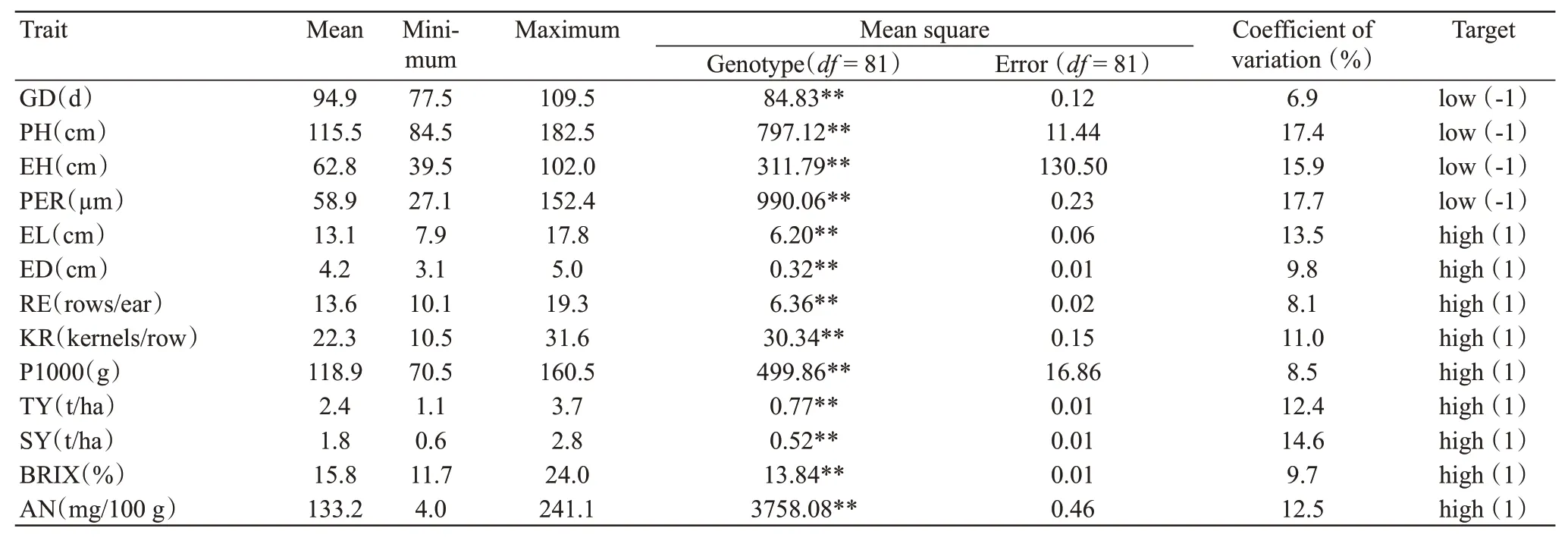
Table 1 Descriptive statistics of corn agronomic parameters in Autumn-Winter in 2019
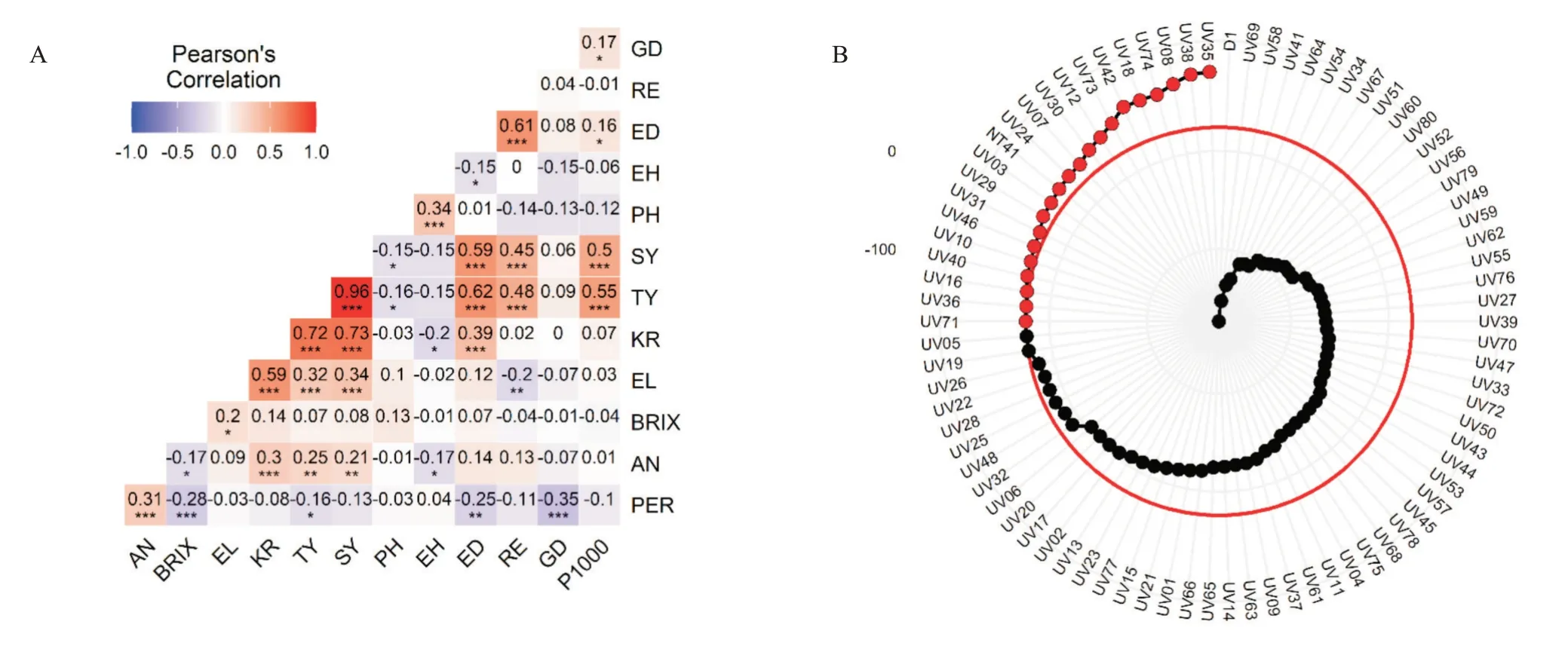
Fig.2 Heat map of the correlation between agronomic traits(A)and radar chart of elite purple sweet corn lines selected according to Smith-Hazel index(B)
Twenty elite purple sweet corn lines,.,UV35,UV38,UV08,UV42,UV18,UV74,UV73,UV12,UV30,UV07,UV24,UV03,UV29,UV31,UV46,UV10,UV40,UV16,UV36 and UV71(Fig.2-B),were selected via multiple traits selection method according to Smith-Hazel index of 13 agronomic traits(GD,PH,EH,PER,EL,ED,RE,KR,P1000,TY,SY,BRIX,AN)with a selection intensity of 25%.These elite lines had a BRIX ranging between 13.0-23.3,PER 29.7-113.5µm,AN 105.9-237.9 mg/100 g,SY 1.3-2.8 t/ha(Table 2).The traits’evaluation of check purple waxy corn parental line NT41 ranked the 12and the donor parent white sweet corn line D1 ranked the last.Two testers,.,T1(SW1-yellow sweet corn line)and T2(D181-pure white sweet corn line),with BRIX of 18.2-19.5,were proven having higher quality compared to thin pericarp group with PER<60.0µm according to the classification of Choe(2010).
Nine lines,.,UV03,UV07,UV08,UV10,UV12,UV16,UV18,UV42,and UV71 had BRIX>16,PER<60.0µm,AN>100.0 mg/100 g,therefore,they could be classified as super sweet purple sweet corn lines(Fig.3).And 20 elite lines were planted for crossing under a Line×Tester mating design with 2 testers,T1 and T2,in the Spring season,2020 to further test their combining ability.
2.2 Evaluation on agronomic characters of topcross hybrids in Autumn-Winter season
In Autumn-Winter season,2020,combining ability analysis was conducted on 40 topcross hybrids and 2 check varieties,.,purple waxy corn hybrid Fancy111 and yellow sweet corn hybrid SW1011.The results,as shown in Table 3,indicated that the time from sowing to fresh ear harvesting of hybrids ranged from 77.0(TH11)to 86.0 d(check variety Fancy111).SW1011 had an average fresh corn harvest time of about 83.5 d(Table 3).
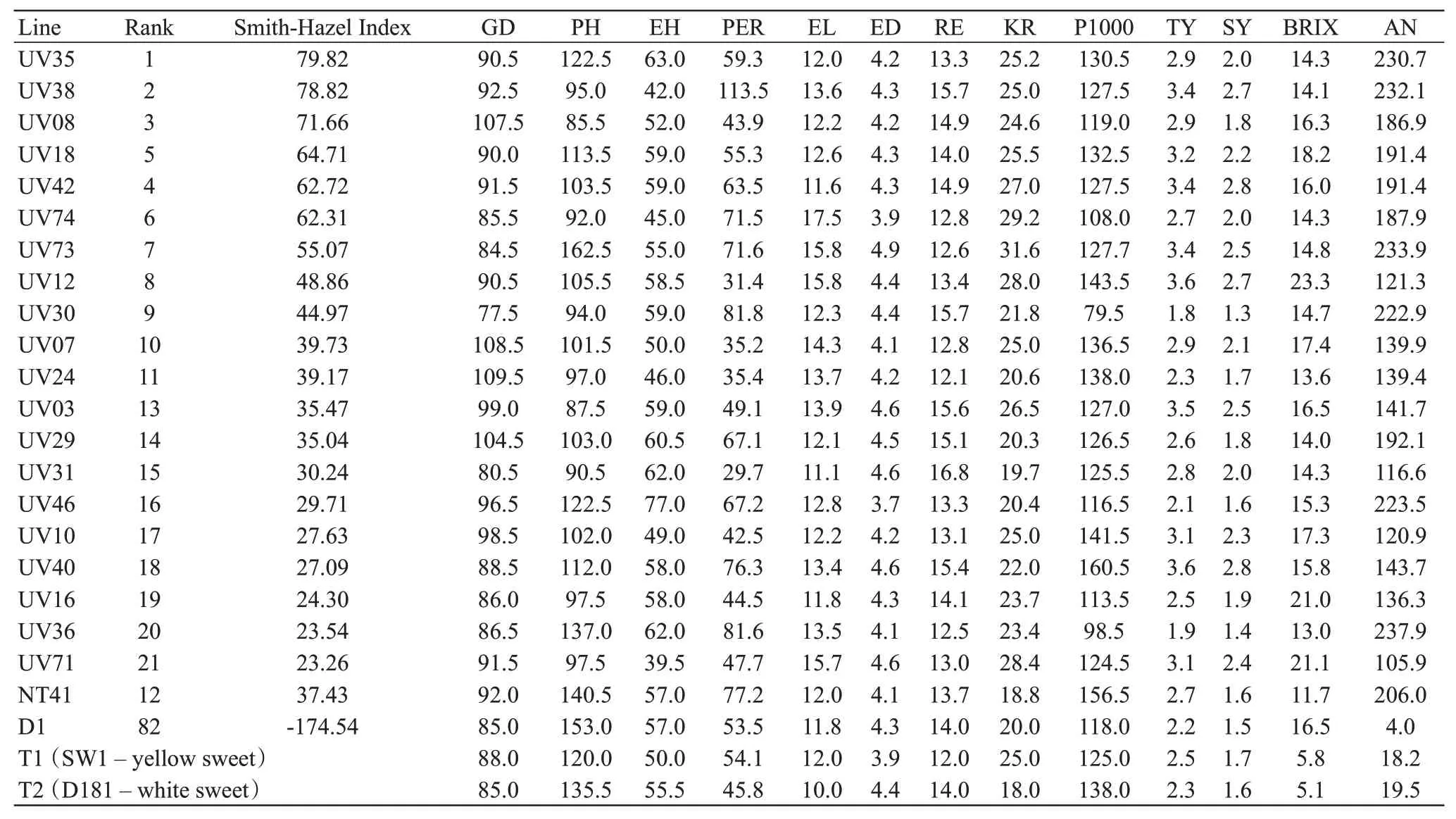
Table 2 Agronomic traits of 20 selected elite purple sweet corn lines with check parental lines and 2 testers
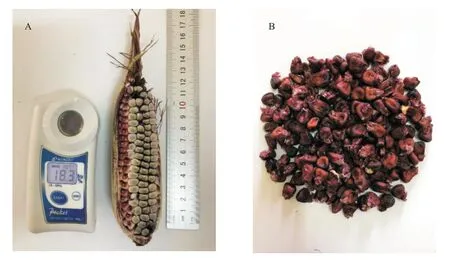
Fig.3 Super sweet purple sweet corn line UV10 BRIX at 20 d after pollination(A)and thin-pericarp dry seeds separated from the endosperm(B)
Seven hybrids,TH39,TH03,TH13,TH19,TH30,TH06 and TH11,had a short fresh ear harvest time from 7 to 10 d,significantly shorter(<0.05)than that of the 2 check varieties SW1011(83.5 d)and Fancy111(86.0 d).
PH,EH of topcross hybrids were measured from 10 randomly selected plants after pollination in each plot.The 3 replicates represented the mean PH and EH of hybrids,respectively.PH of topcross hybrids ranged from 158.3 cm(Table 3)(TH02)to 211.1 cm(TH04).Some hybrids,such as TH23,TH30,TH13,TH11,TH32,TH20,TH33,TH36,and TH10,had no significant difference(>0.05,the same below)in PH compared with check Fancy111(184.1 cm).Some hybrids,including TH11,TH32,TH20,TH01,TH35,TH40,and TH03,were found to have no significant difference in PH as compared to SW1011(181.1 cm).The remaining hybrids had significantly lower PH than the 2 check varieties(<0.05).The EH of these hybrids varied from 62.6(TH21)to 89.4 cm(TH09).Overall,all hybrids had low EH/PH ratio,ranging between 31.1%-51.8%.Ear cover of TH02,TH03,TH07,TH21,TH25,TH32,TH33,and TH37 had tight husk cover at the tip of corn ear(2 scores).The remaining hybrids had very tight husk cover(1 score)that was equivalent to the 2 check varieties.All topcross hybrids had purple seed coat at fresh corn harvesting time,indicating the dominant of purple color trait was completely inherited from the UV purple sweet corn lines.Interestingly,all hybrids had uniform shrunken kernel type,which might from sweet corn parental lines.However,endosperm color seemed to be inherited from the maternal lines.The endosperm of the hybrids crossed between the UV lines and tester T1(yellow sweet corn)was yellow color as same as the check SW1011,and the endosperm of the hybrids crossed between UV lines and tester T2(white sweet corn)were white.

Table 3 Agronomic traits of topcross hybrids in Autumn-Winter in 2020
Thirty plants from the second and third rows in each plot had straight-shape ear,and high tip fill was collected and dehusked to measure MY.MY(t/ha)of each hybrid was calculated based on total weight of 30 dehusked cob/30×plant density 57,000 plants/ha.The results showed that the MY of topcross hybrids ranged from 9.65 t/ha(TH16)to 14.37 t/ha(TH08).In addition,6 hybrids,TH08,TH27,TH18,TH35,TH31 and TH17,had high MY,and their yield were equivalent to that of their high-yielding check yellow sweet corn variety SW1011(13.96 t/ha)(Table 4).Seventeen hybrids had MY ranging between 12.02-13.14 t/ha,significantly higher than that of check variety Fancy111(11.12 t/ha)(<0.05).The extraordinary differences in the genetic background of the purple sweet corn lines in comparison with 2 testers(yellow sweet and white sweet corn inbred lines)could be the main reason of high hybrid vigor in the marketable yield of most hybrids.When Hochholdinger and Baldauf(2018)and Labroo et al.(2021)summarized the phenomenon of heterosis,they also highlighted that increasing genetic diversity of the parents could contribute to high hybrid vigor.
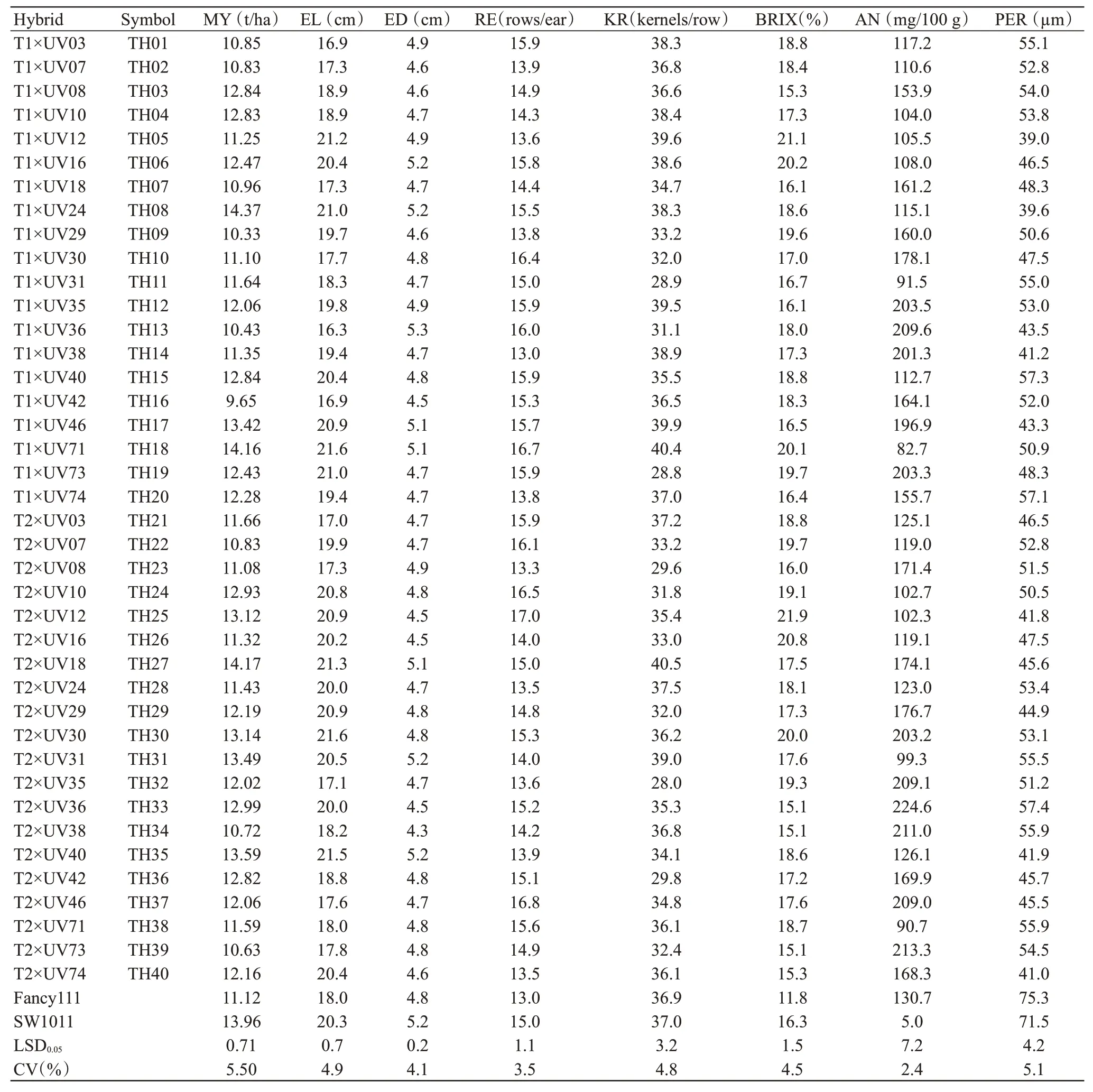
Table 4 Marketable yield,yield components,and qualities of topcross hybrids in Autumn-Winter in 2020
EL and ED of the 10 randomly selected plants in each replicate were measured and the 3 replicates represented the mean EL and ED of hybrids,respectively(Table 4).The results showed that the EL of these hybrids ranged from 16.3 cm(TH13)to 21.6 cm(TH30).The hybrids,.,TH30,TH18,TH35,TH27,and TH05,had significantly longer ear length than check variety SW1011(20.3 cm)(<0.05)such as TH30,TH18,TH35,TH27 and TH05.ED of hybrids ranged from 4.3 cm(TH34)to 5.3 cm(TH13).Eight trials including TH13,TH35,TH06,TH08,TH31,TH18,TH17 and TH27 had the same corn diameter as SW1011(5.2 cm)and were higher than Fancy111(4.8 cm)(<0.05).RE of topcross hybrids ranged from 13.0(TH14)to 17.0(TH25).Especially,and RE of 5 hybrids including TH25,TH37,TH18,TH24,and TH10 were significantly higher than that of the check varieties SW1011(15.0),and Fancy111(<0.05).KR of the hybrids ranged from 28.0(TH32)to 40.5(TH27),in which TH27,TH18,TH17,TH05,and TH12 had significantly higher KR than the 2 check varieties SW1011(37.0 kernels/row),and Fancy111(36.9 kernels/row)(<0.05).
The quality parameters included the BRIX of the hybrids that ranged from 15.1%(TH33,TH34,TH39)to 21.9%(TH25).BRIX of 21 hybrids ranged from 18.0% to 21.9%,significantly higher than that of the check variety SW1011(16.3%)(<0.05).BRIX of all topcross hybrids were significantly higher than that of Fancy111(11.8%)(<0.05).
AN of topcross hybrids ranged between 82.7(TH18)and 224.6 mg/100 g(TH33).In addition,AN of 22 hybrids varying from 153.9 to 224.6 mg/100 g were significantly higher than that of the check variety Fancy111(130.7 mg/100 g)(<0.05).All hybrids had superior AN compared to the check variety yellow sweet corn SW1011.Mean PER of the hybrids ranged from 39.0(TH05)to 57.4µm(TH33).Thus,all hybrids were categorized into thinpericarp group<60.0µm,according to the classification proposed by Choe(2010).
2.3 Combining ability analysis by Line×Tester model
The ANOVA of 5 yield traits and 3 quality traits showed that the mean square of the line,tester,and Line×Tester interaction were statistically significant(<0.01)for all traits except the effect of the tester on BRIX and PER(Table 5).The additive variance of the marketable yield,yield components,and PER were 0.This result indicated that these traits were 100% influenced and regulated by the genotype effect.An additive effect(σA=3.16)and a dominant effect(σD=6.43)were detected on BRIX.When white waxy corn lines(male line)were crossed with yellow sweet corn lines(female line)to evaluate combining ability,Fuengtee et al.(2020)found that the additive effect played an important role to improve the total sugar content in the offspring,which parental lines with high BRIX were required for better hybrids.In this study,when crossing the purple sweet corn lines with the yellow sweet line and the white sweet corn line,the additive effect was somewhat weaker than the dominant effect.When crossing the sweet purple male line with the female lines as what had been done for yellow sweet and white sweet test plants,the additive effect(σA=5071.29)was found to be very strong on the AN trait.All hybrids had purple seed coat at fresh ear harvesting time.PER was dominated by the dominant effect(σD=139.43)while no additive effect was detected(σA=0).Although some UV sweet purplecorn lines,such as UV38,UV30,UV36,UV40,UV73,UV74,UV46,UV29,UV42 and UV35,still had relatively thick skins,all female lines T1,T2 had thin pericarp,and therefore,all topcross hybrids classified as the thin-pericarp ones according to Choe(2010).This may be explained by that the thin pericarp trait was inherited from parental lines(Tran et al.,2017)and affected by additive effect,dominant effect and epistatic interactions with high narrowsense heritability(55%-82%)(Wu et al.,2020).
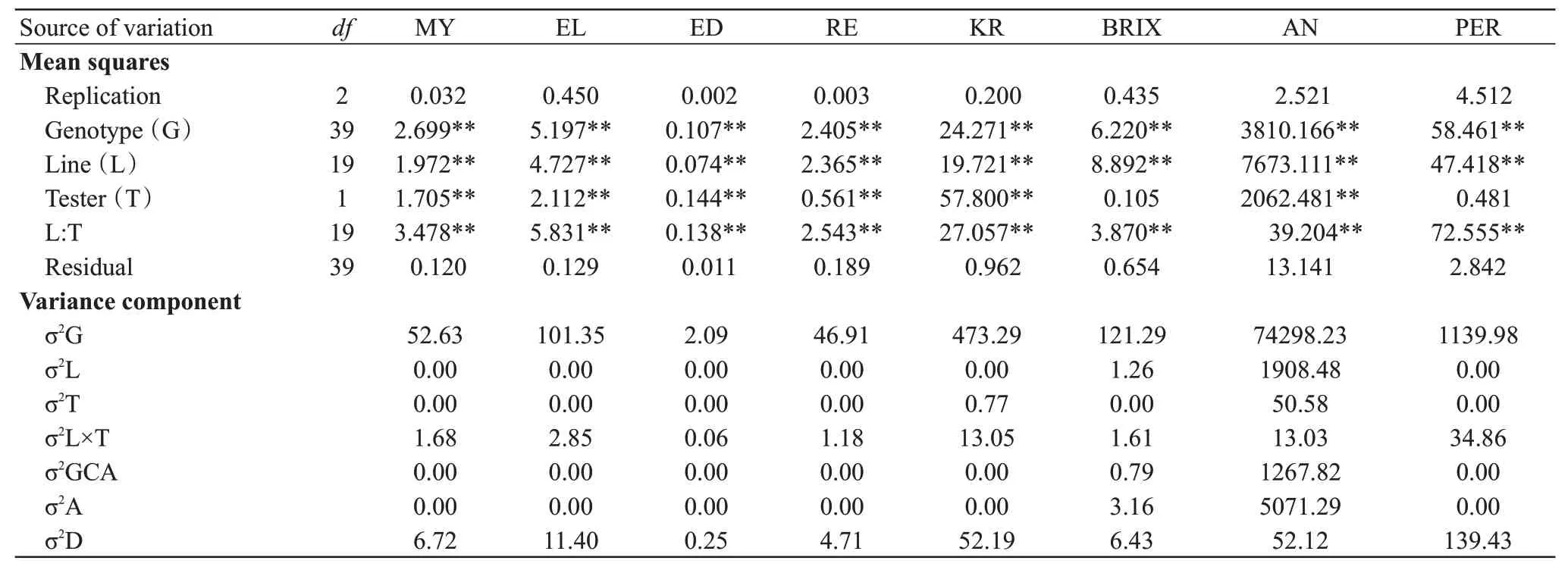
Table 5 Mean squares and variance components for yield,yield components,and quality traits of hybrids evaluated in Autumn-Winter in 2020
Seen from the data in Table 6,5 UV lines ranked from high to low including UV40,UV24,UV10,UV71,UV46 had high GCA of MY.Three lines,.,UV12,UV40,UV24 had high GCA in terms of corn length.Five lines ranked from highest to lowest including UV40,UV71,UV31,UV36,UV24 that had high GCA in terms of corn diameter.Fours lines,UV46,UV71,UV03 and UV30,had high GCA in RE.For KR trait,6 lines,namely UV71,UV24,UV38,UV03,UV18 and UV12,had high GCA.Purple sweet corn inbred lines UV12,and UV16 had high GCA on BRIX.Five lines UV36,UV73,UV35,UV38 and UV46,had high GCA in AN.Two lines,UV31 and UV71,had high GCA value in terms of PER.

Table 6 General combing ability for yield,yield components and qualities of parents
3 Discussion
In recent years in Vietnam,a new type of fruit corn,a corn that can be eaten directly at the fresh harvesting time without cooking was introduced(Nguyen et al.,2020).To meet market requirement,the fruit corn variety should have some special characteristics such as sweet,tender texture,thin pericarp,short GD,long shelf life,and especially high nutrient values.In order to achieve such objective and develop nutrient-rich fruit corn variety,this study used backcross and selfing methods based on morphological markers(purple and shrunken kernel types)to select and develop purple sweet corn inbred lines.Since the corn ideotype model proposed by Mock and Pearce(1975)and Gong et al.,(2015),elite inbred lines/hybrids selection methods based on multiple traits had been widely applied and was believed to be effective to select genotypes that are the closest to the ideotype model(Céron Rojas and Crossa,2018).Twenty purple sweet corn inbred lines were selected based on multi-traits selection based on Smith-Hazel index.
In this study,despite of some UV lines with thick pericarp,all topcross hybrids have thin pericarp.This may be explained by the fact that the thin pericarp trait was inherited from parental lines(Tran et al.,2017)and affected by both additive effect,dominant effect,and epistatic interactions with high narrow-sense heritability(55%-82%)(Wu et al.,2020).
The effectiveness of hybrids depends greatly on the phenotypic selection of the parents,and their combining ability is the key to improve the quality and yield of corn varieties(Yu et al.,2020).The effect of GCA is useful for identifying superior parental lines for direct use in breeding programs(Mahan et al.,2013).Superior inbred lines must have high GCA for yield and quality traits,which are different from zero at a significance level,greater than or equal to standard error(SE),and the mean value of these traits must be high in the topcross hybrids.Based on GCA analysis,this study had found:5 lines,UV10,UV24,UV40,UV46 and UV71,with high GCA value in terms of marketable yield;UV12 and UV16 with high GCA in terms of BRIX;UV36,UV73,UV35,UV38 and UV46 with high GCA regarding AN.Crossing a purple line with a white line will lead to a purple ear if the female was purple,or a white ear if the female was white,because corn ear,just the same as pericarp tissue,is actually maternal tissue.Purple pigment is dominant in maize genetic.Therefore,all topcross hybrids had purple kernel pericarp.
To claim the developed lines as super sweet purple sweet corn,profiling the concentration of anthocyanin as well as sugar are important.For example,there are cyanidin-based(deep purple),anthocyanin-and-pelargonidin-based(reddish-purple)anthocyanin due togene.Phlobaphene is also responsible for red pigment in the pericarp.The results from Fig.3-B indicated that pericarp color may be due to pelargonidin type of anthocyanin or there is phlobaphene present in the pericarp,which will neutralize the claim that it is marketable.Therefore,the limitation of this study on identifying the type,amount,percentage of anthocyanin found,and the total sugar(fructose,glucose,sucrose,etc.)are essential for the validation of present as well as future experiments,from scientific as well as consumer point of view.
4 Conclusion
Nine lines.,UV03,UV07,UV08,UV10,UV12,UV16,UV18,UV42,and UV71 with BRIX>16%,PER<60µm,AN>100 mg/100 g can be developed as super-sweet purple sweet corn inbred lines.Six hybrids.,TH08(T1×UV24),TH17(T1×UV46),TH18(T1×UV71),TH27(T2×UV18),TH31(T2×UV31)and TH35(T2×UV40),are found to have superior quality and high marketable yield,with potential to be further developed as commercial super sweet purple corn varieties.UV10 and UV12 purple sweet corn lines had high GCA for marketable yield and quality,respectively.
